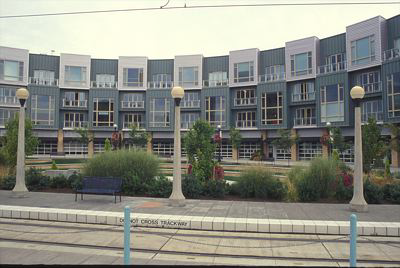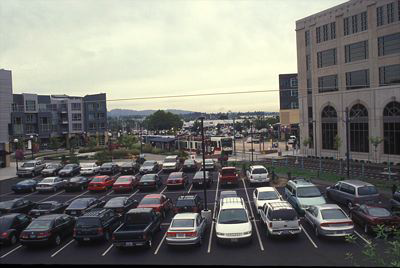No Light Rail in Vancouver!
“So What? Everything Is Subsidized.”

Beaverton Round, a transit-

The Beaverton Round. Photo by John Charles.
“All residential construction is subsidized,” says Portland planner Carl Hosticka. So he sees nothing wrong with throwing more good money after bad.
I hear this argument all the time. “All transportation is subsidized,” say rail advocates,
“so it is okay to spend billions of dollars on light-
These people are either innumerate or deliberately misleading. I think very few things
should be subsidized, but when they are we have to keep them in proportion. Subsidies
to highways amount to well under a half a penny per passenger mile of travel. Such
tiny subsidies do not justify the 65-
In the same way, whatever tiny subsidies go for ordinary housing do not justify the
huge subsidies needed to prop up Portland’s transit-

The original plan for Beaverton Round.
Since it was on a light-
After sitting uncompleted for several years, the city of Beaverton coughed up some more money and enticed a new developer to finish the project — but the developer insisted on having lots of parking.

Unplanned parking. Photo by John Charles.
But the city demanded that the developer replace the surface parking with a garage and finish building the planned retail area on the parking lot. Garage parking costs much more than surface parking, and eventually the new developer defaulted as well.
According to The Costs of Sprawl 2000, it costs about $11,000 more per unit to provide
urban services to typical low-
It is clear, however, that most homebuyers are willing to pay an extra $11,000 to
be able to own their own single-
In contrast, part of the problem with high-
So Hosticka (who was an urban planning professor before he was elected to the council of Metro, Portland’s regional planning authority) is blowing hot air when he justifies subsidies to places like the Round based on supposed subsidies to other housing. He points to planned subsidies to new developments elsewhere in the Portland area without noting that those subsidies exist only because Metro planners decreed that they should exist.
If planners would allow builders to build the homes that people wanted to buy, homebuyers
would gladly pay the full cost of their housing. And if there were no planning-
Trackback • Posted in City planning, News commentary
10
Reprinted from The Antiplanner